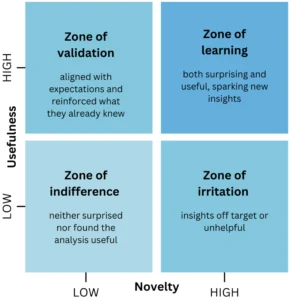This article explores how AI executive communication tools, powered by GPT-4, can enhance leadership skills and improve coaching. Research findings show that AI tools can be an efficient, accessible way for executives to sharpen their communication abilities.
***
Strong executive communication is crucial for effective leadership. Research findings show that executives can benefit from tools that provide real-time feedback on their communication. AI executive communication tools, in particular, are being explored as a way to assist executives in improving their coaching styles. These tools mimic the role of a human coach, helping leaders engage with their teams and improve key skills. Thus, they enhance abilities like asking good questions, resolving conflicts, and giving meaningful feedback. As the capabilities of AI continue to evolve, it becomes increasingly feasible for these tools to support executives seeking to refine their leadership capabilities. The research presented here tested the potential of GPT-4-powered AI to provide coaching feedback, with promising results.
Two Ways AI Can Improve Executive Communication
AI tools can support executives in improving communication and coaching skills in two primary ways: offering advice or assessing interactions.
Way 1. Offering Advice
One approach is for executives to use AI as a leadership coach. In this case, they would describe a situation—perhaps a challenging conversation—and ask the AI tool for advice. For example, an executive might provide a brief description of a scenario with a team member. Then, they could prompt the AI with questions like, “How should I approach this situation?” or “What communication style would be most effective here?”. This allows executives to gain insights into potential communication strategies they might not have considered.
The more specific the executive’s questions, the more tailored and valuable the response. In many instances, AI can help executives identify the most productive ways to engage with their teams or clients. As a result, they become more effective in their communication.
Way 2. Asking for Assessment
Another option is to use AI tools to assess the executive’s communication during or after an actual conversation. The AI can listen in on a dialogue and then provide feedback about the executive’s communication style. Research findings show that the more specific the prompts used for assessment, the more insightful the feedback. For instance, the tool can identify whether the tone was appropriate, if the word choice was effective, or whether the executive’s communication was productive.
Incorporating AI assessments can provide executives with real-time, granular feedback. With the right prompts, these tools can identify patterns in speech, helping executives to refine their approach over time.
Enhancing Coaching Skills with AI Tools
AI tools offer significant potential for executives seeking to improve their coaching abilities. The research team used GPT-4 to analyse real coaching sessions, applying John Heron’s coaching styles framework to assess the communication and approach used. Heron’s framework categorises six styles of coaching: prescriptive, informative, catalytic, cathartic, supportive, and confronting. These styles represent different ways of interacting with employees and guiding them toward solutions.
AI evaluation of coaching sessions helped executives understand which styles they used most frequently. Consequently, they could assess whether their use of each style was appropriate for the situation. For example, an executive could ask the AI tool, “What is my coaching style according to Heron’s framework?”. Moreover, they could inquire “How effectively did I perform as a coach?”. This kind of feedback is valuable because it helps leaders understand how their actions influence the dynamic with team members.
Real-world Feedback: The Impact of AI on Executive Communication
During the experiment, executives from a range of industries interacted with AI tools, providing insights into the potential of these technologies. One senior executive from a Scandinavian company, initially sceptical about the tool, noted that, after using it, they recognised the value of understanding how technology could enhance leadership skills. This reflects how AI executive communication tools can offer both surprising and valuable insights for leaders seeking to grow.
In one case, the AI detected a choice an executive had considered but not voiced. The AI suggested the alternative path in its feedback, offering a surprising yet useful insight. Similarly, executives who provided more specific prompts—like requesting specific examples—found that the feedback was more useful and actionable.
Zones of Feedback: How Executives Rated the AI Tool’s Effectiveness
The research also evaluated the executives’ perceptions of the AI-generated feedback. The finding were categorised into four zones based on the novelty and usefulness of the feedback.
Figure 1: Zones of feedback
Source: adapted from Harvard Business Review (HBR, 2025)
Zone 1: Validation
In this zone, feedback aligned with the executive’s own perceptions, providing reassurance. While this was useful for confirmation, the challenge for executives in this zone is to move beyond validation. Hence, they must recognise subtler opportunities for growth.
Zone 2: Learning
Most executives (55%) found the feedback to be both surprising and useful. In this dynamic zone, AI tools provided insights that challenged their assumptions, leading to greater self-awareness and improved communication. This is where AI tools proved most effective in encouraging growth.
Zone 3: Irritation
About 10% of participants experienced friction, as the AI’s feedback did not resonate with their self-perception. While frustrating, this zone presented an opportunity for executives to reflect on why they felt discomfort. Moreover, it encouraged them to explore ways to improve.
Zone 4: Indifference
A small percentage of executives (5%) found the AI feedback unhelpful or irrelevant. This highlights the importance of tailoring prompts and aligning expectations to gain more meaningful insights.
The Limitations of AI in Executive Communication
While AI executive communication tools can offer valuable feedback, they do have limitations. One concern is the privacy and security of the data used by these tools. Since sensitive conversations are often involved, executives must ensure that proper data protection measures are in place.
Another limitation is that AI sometimes produces inaccurate or misleading feedback, which can misguide development. Leaders should always critically evaluate AI-generated insights and use them alongside human feedback to verify their validity.
AI also struggles to interpret cultural nuances and emotional dynamics. These factors are crucial in coaching, and AI tools should complement, not replace, human expertise in these areas.
Key Takeaways: Using AI for Executive Communication Growth
– Use structured frameworks: Executives should use frameworks like Heron’s coaching styles to guide their prompts. This ensures more targeted and actionable feedback.
– Embrace unexpected insights: AI can provide feedback that challenges an executive’s self-perceptions. Reflecting on these surprises can lead to meaningful growth.
– Combine AI with human feedback: AI assessments are most powerful when paired with human interpretation. This creates a dual feedback loop that helps executives refine their communication skills.
***
In brief, research findings show that AI executive communication tools can significantly enhance leadership development. By using AI-powered tools to assess and improve their communication styles, executives can gain valuable insights and refine their approach. While AI tools are not perfect, they offer an accessible, efficient, and potent way to boost leadership effectiveness. As these tools continue to evolve, they will increasingly support executives in becoming better communicators and coaches.
Source: Harvard Business Review (HBR, 2025)
At AFS, we are passionate about fostering innovation and empowering ambitious minds to flourish. Our mission is to provide best-in-class financial services for traditional and crypto deals, exploit European grants, and use quantitative methods to improve clients’ performance. We aim to help our customers unlock their full business potential.
Let’s unlock your enterprise’s full potential together!
Get in touch at [email protected].



